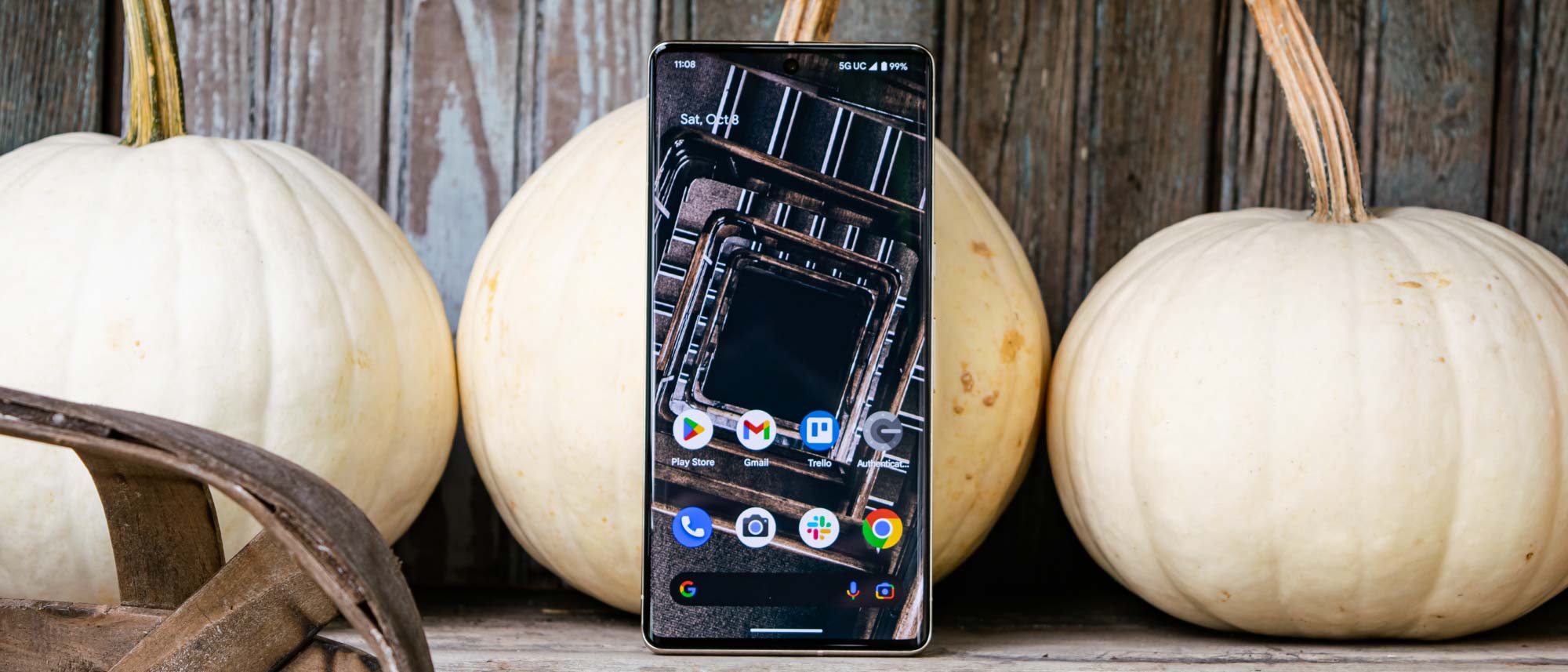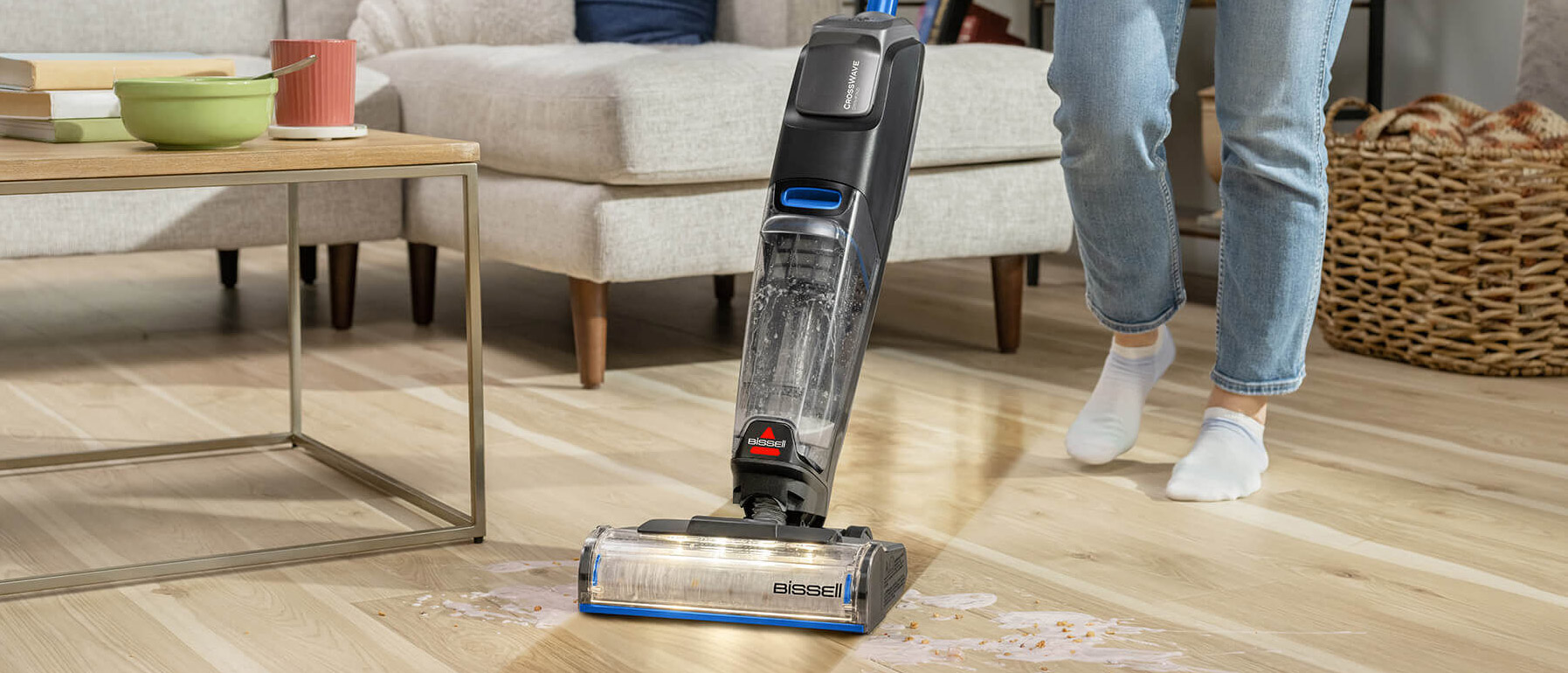Tom's Guide Verdict
The Pixel 7 Pro is the ideal follow-up to last year’s excellent Pixel 6 Pro. Not only is the design more refined, but the latest Google flagship sports several key upgrades and features. From impressive zoom to the new Tensor G2 tricks, this is Google’s best phone yet.
Pros
- +
Beautiful design
- +
Incredible cameras
- +
Even more useful software features
- +
Excellent value
Cons
- -
Only three years of platform updates
- -
Lackluster colors in telephoto
- -
Underwhelming battery life
Why you can trust Tom's Guide
Price: Starting at $899 / £849 / AU$1,299
Android version: 13
Display: 6.7-inch OLED (3120 x 1440)
Refresh rate: 10-120Hz
CPU: Tensor G2
RAM: 12GB
Storage / Expandable: 128GB, 256GB / No
Rear cameras: 50MP (f/1.85) main, 12MP (f/2.2) ultrawide, 48MP (f/3.5) 5x telephoto
Front camera: 10.8MP (f/2.2)
Battery: 5,000 mAh
Battery life (Hrs:Mins): 8:04 (adaptive)
Charging: 30W wired, fast wireless
Size: 6.4 x 3 x 0.3 inches (162.9 x 76.6 x 8.9 mm)
Weight: 7.5 ounces (212g)
Colors: Obsidian, Snow, Hazel
The Pixel 7 Pro proves that Google has gotten truly serious about its smartphones, though not as serious as I'd like. With a beautifully refined design, this new flagship pulls out all the stops on its quest to be the best Android phone. And believe me when I say it’s darn well close to that title. Thanks to its amazing cameras, new Tensor G2 chip, brighter display, and excellent value, the Pixel 7 Pro might be my new favorite Android device.
The Galaxy S23 Ultra better look out because the Pixel 7 Pro costs significantly less than Samsung’s top handset. Google’s latest device fixes many of the issues I had last year with the Pixel 6 Pro, including a faster fingerprint sensor and better anecdotal battery life.
Google’s updated Tensor G2 silicon is yet another point in the Pixel 7 Pro’s favor. Not only is the chipset in this year’s phone a lot faster than the first-generation (just shy of the Snapdragon 8 Gen 1 in our testing), but it provides heaps of new AI and machine learning tricks that are unique to the Pixel 7 Pro (and the Pixel 7). Seriously, some of these new capabilities are wild, like Photo Unblur and the faster Night Sight.
As you’ll see in this Pixel 7 Pro review, Google knocked it out of the park and I’m not just saying that because I like Pixels. This phone takes the vision started with the Pixel 6 series and cranks it up a notch.
If you’d like to save even more money over other flagships, then check out our Pixel 7 review. And see our Pixel 7 Pro vs Galaxy S23 Ultra and Pixel 7 Pro vs iPhone 14 Pro face-offs to see which flagship wins.
Google Pixel 7 Pro review: Price and availability
The Pixel 7 Pro starts at $899 / £849 / AU$1,299 for a base model with 12GB of RAM and 128GB of storage. For $999 / £849 / AU$1,499 , you can jump up to 256GB, or get 512GB for $1,099 / AU$1,599. That’s a great value considering the likes of the Galaxy S22 Ultra ($1,199), iPhone 14 Pro ($999) and iPhone 14 Pro Max ($1,099) all feature 128GB in their base models. You simply get more storage for your buck with the Pixel 7 Pro.
Even lower on the totem pole, the Pixel 7 Pro is only $100 more than the Galaxy S22 and iPhone 14, $100 less than the Galaxy S22 Plus, and the same price as the iPhone 14 Plus. Yet, Google’s handset offers more than those phones, such as a telephoto lens with a 5x optical zoom. The iPhone 14 and iPhone 14 Plus don’t even have telephoto lenses or adaptive 120Hz displays.
The Pixel 7 Pro went on sale last October, and you can find it at all major carriers as well as on retail site like Amazon and Best Buy. Since releasing its flagships last fall, Google has subsequently come out with the cheaper Pixel 7a, which costs $400 less than the Pixel 7 Pro while featuring a Tensor G2 chip of its own. Note that the Pixel 7 Pro has a bigger display with a faster refresh rate, and it's the only current Pixel with a dedicated telephoto lens.
Google Pixel 7 Pro review: Design
Let’s take a moment to admire the Pixel 7 Pro, especially the Hazel colorway I received for review. You can clearly see the design language that Google introduced last year, but the company refined it to a T for 2022. Whether it’s the metal camera bar that seamlessly blends into the frame or the prominent camera lenses that immediately draw your eye, the Pixel 7 Pro is a beautiful device in all three of its color options.
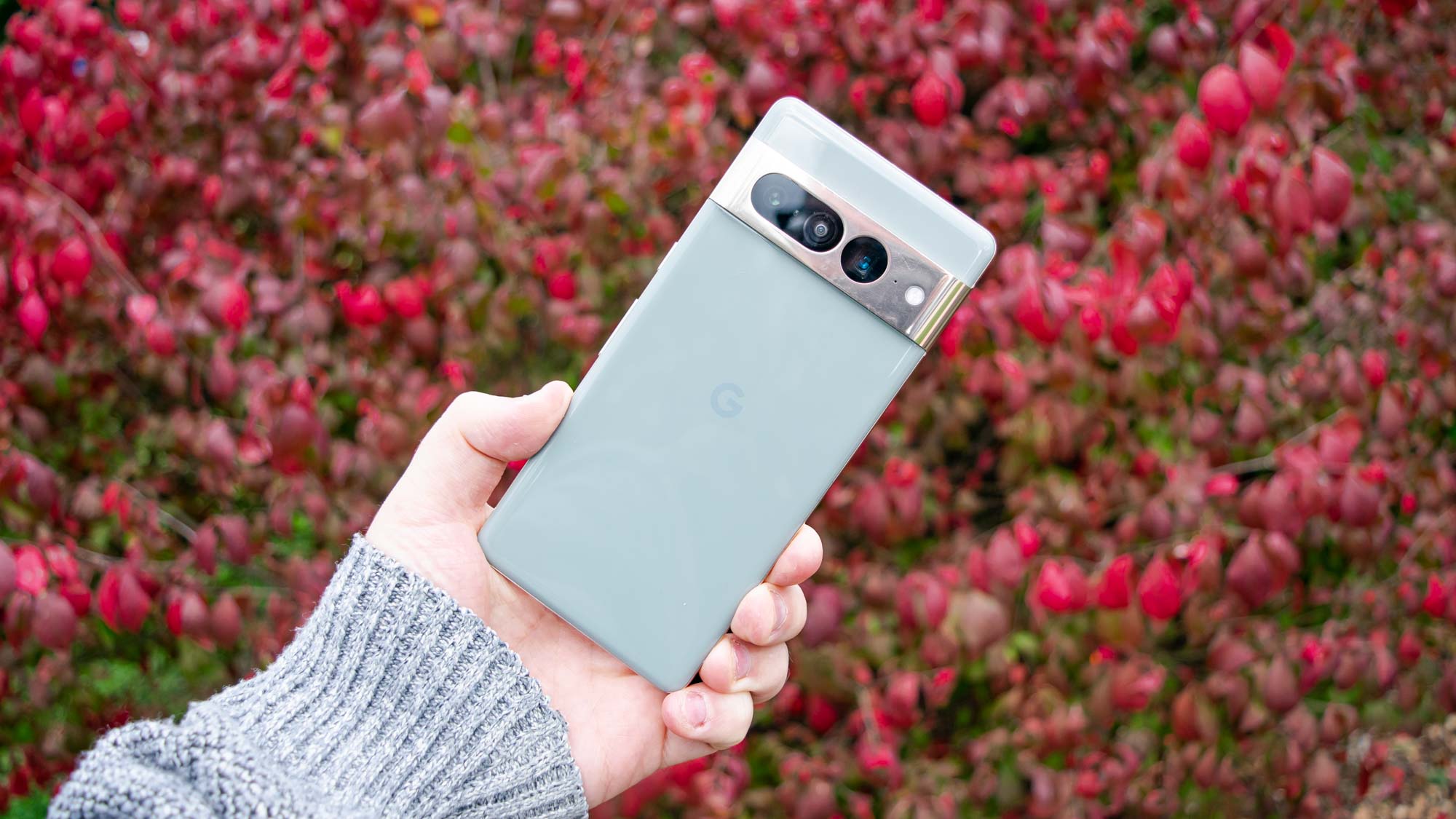
At 7.5 ounces, the Pixel 7 Pro feels heftier than its predecessor (7.4 ounces). It’s a miniscule difference on paper, but that 0.1-ounce difference feels noticeable. And despite a thinner 0.3-inch profile, the latest Pixel feels no less chunkier than the Pixel 6 Pro. It’s odd since my perception doesn’t line up with the numbers. Yet, I noticed it immediately upon picking up the Pixel 7 Pro. (I’ve been using the Pixel 6 Pro consistently since it launched, which is why I bring this up.)
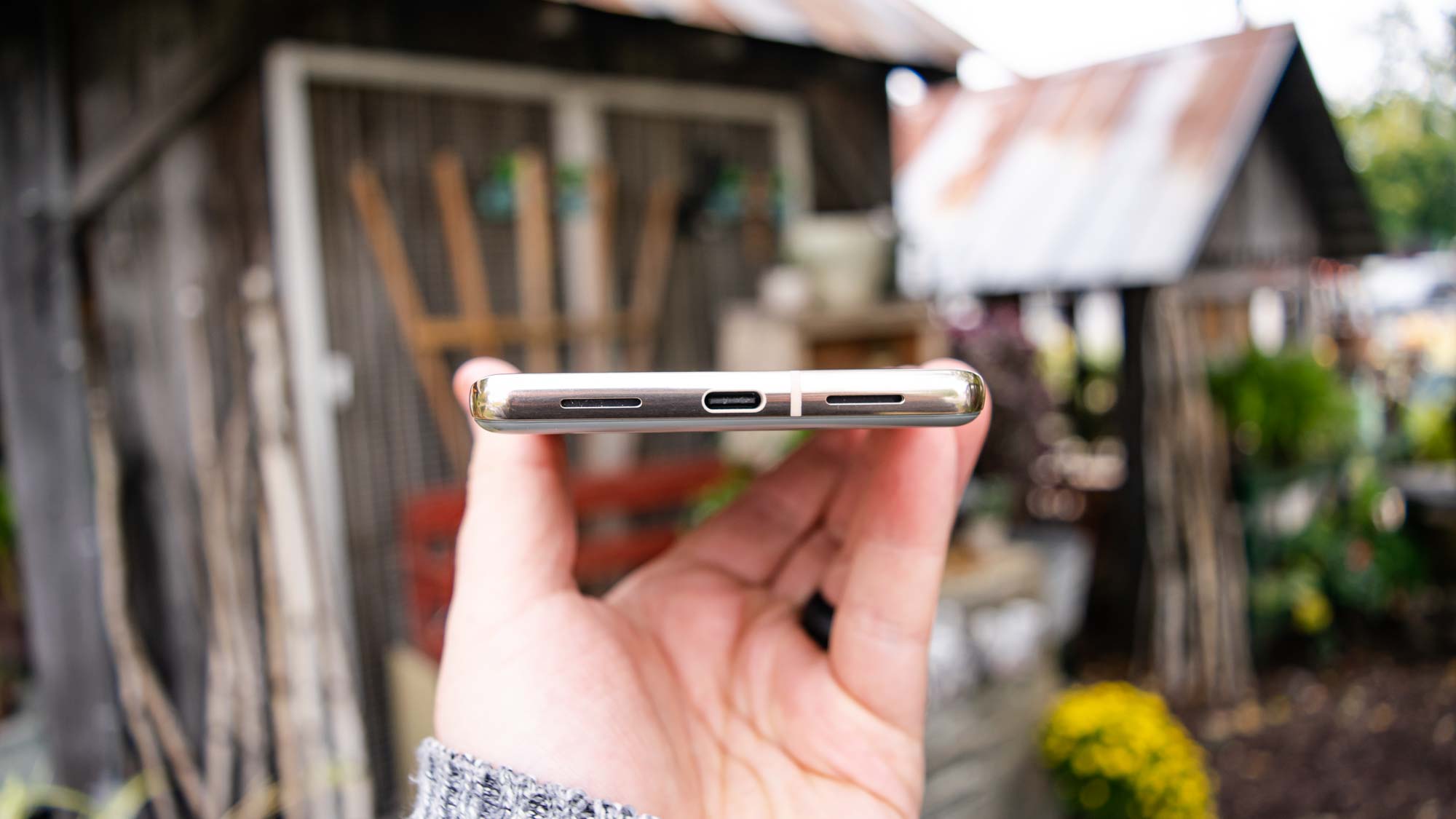
If I had to lodge one complaint against the Pixel 7 Pro’s hardware, it’d be that it’s a slippery device. Whereas the Pixel 7 unit I received in the Lemongrass colorway has some grip along the frame, the new Pro likes to slide out of my hand or off of slightly unlevel surfaces. This was something I’d hoped Google would address this year since the Pixel 6 Pro had the same issue, but shiny and slippery seems to be the name of the game for Pro Pixels. I suppose I can hold out hope for a grippier Pixel 8 Pro.
You can read about how our News Editor had a hard time using the Pixel 7 Pro without a cover.
Google Pixel 7 Pro review: Display
The Pixel 7 Pro sports a 6.7-inch OLED display with a QHD+ resolution. I didn’t mind the Pixel 6 Pro’s display, but I found it a bit lacking in brightness for outdoor use. Google appears to have taken that into consideration this year, because the Pixel 7 Pro is significantly and noticeably brighter.
Some users have recently reported scrolling issues on the Pixel 7 Pro. The reports claim that scrolling on the display is inconsistent and is especially noticeable when upgrading from an older Pixel. In part this could be because of the snappy 120Hz refresh rate on the screen. An update seems to have fixed the issue for a few.
Here’s what we measured for the display.
| Row 0 - Cell 0 | Pixel 7 Pro | iPhone 14 Pro | Galaxy S22 Ultra |
| Display size | 6.7 inches | 6.1 inches | 6.8 inches |
| sRGB (%) | 104.9 (Natural) | 119.8 | 137.5 (Natural) |
| DCI-P3 (%) | 74.3 (Natural) | 84.8 | 97.4 (Natural) |
| Delta-E | 0.28 (Natural) | 0.25 | 0.25 (Natural) |
| Peak brightness (nits) | 927 | 993 (SDR) / 1448 (HDR) | 644 (SDR) / 1359 (HDR) |
Although Google closed the gap between its two biggest rivals, the Pixel 7 Pro’s display still falls behind the iPhone 14 Pro and Galaxy S22 Ultra across all metrics. However, approaching 1,000 nits of brightness is nothing to sneeze at. I can easily see what I’m doing outdoors, which is great for photography sessions.
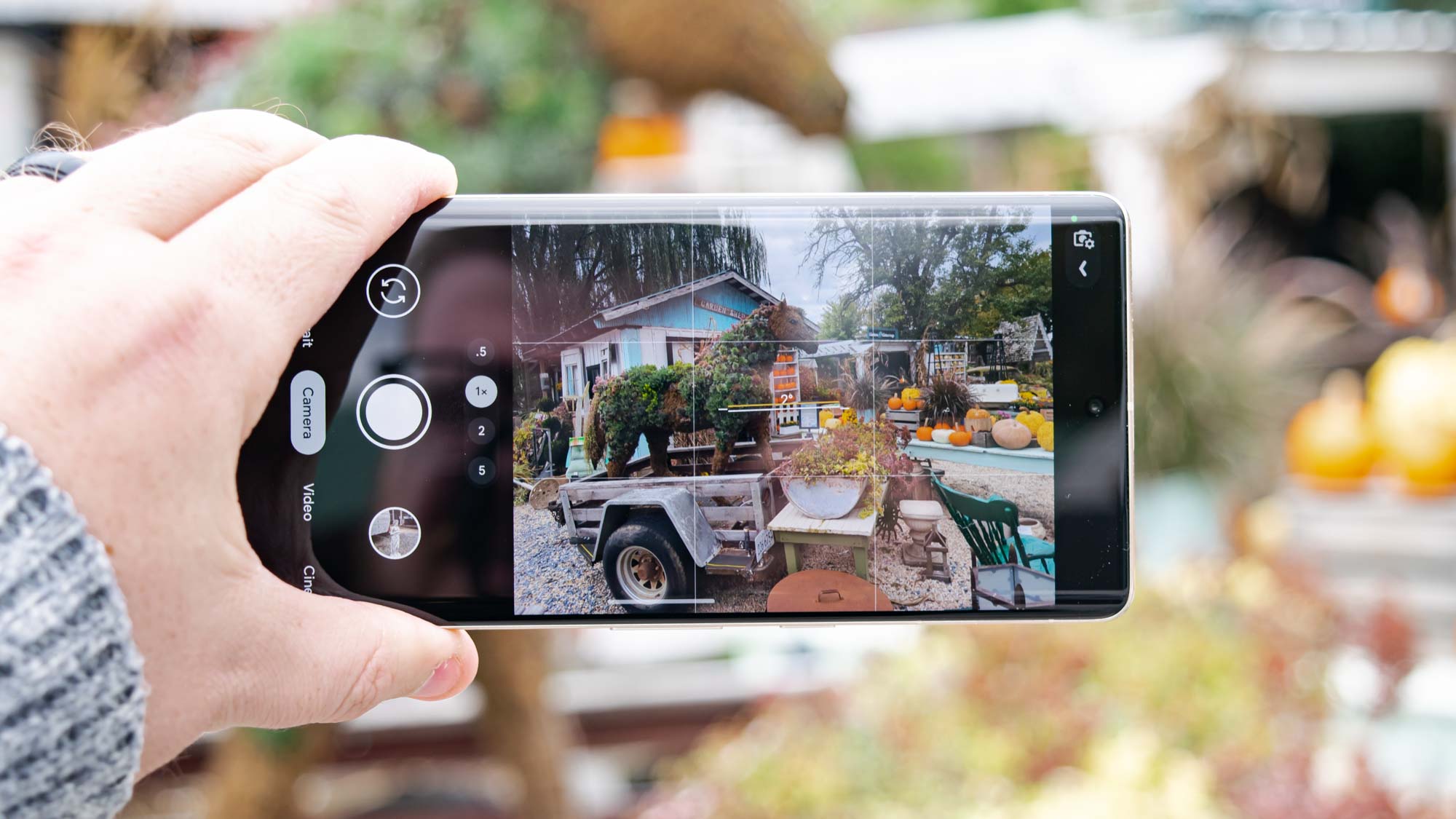
But Samsung is the clear winner when it comes to color reproduction in the sRGB and DCI-P3 gamuts, and it shares the same Delta-E color accuracy score with the iPhone 14 Pro. That said, it’s a known fact by now that Samsung and Apple have the best displays on the market.
In my real-world use, the Pixel 7 Pro’s panel is a step up over last year’s display. Colors absolutely pop with sharp contrast and deep blacks. Watching the trailer for Blade Runner 2049, for example, showed just how rich the neons in that film can look. And with the new Super Mario trailer, Mario’s signature red getup looks amazing.
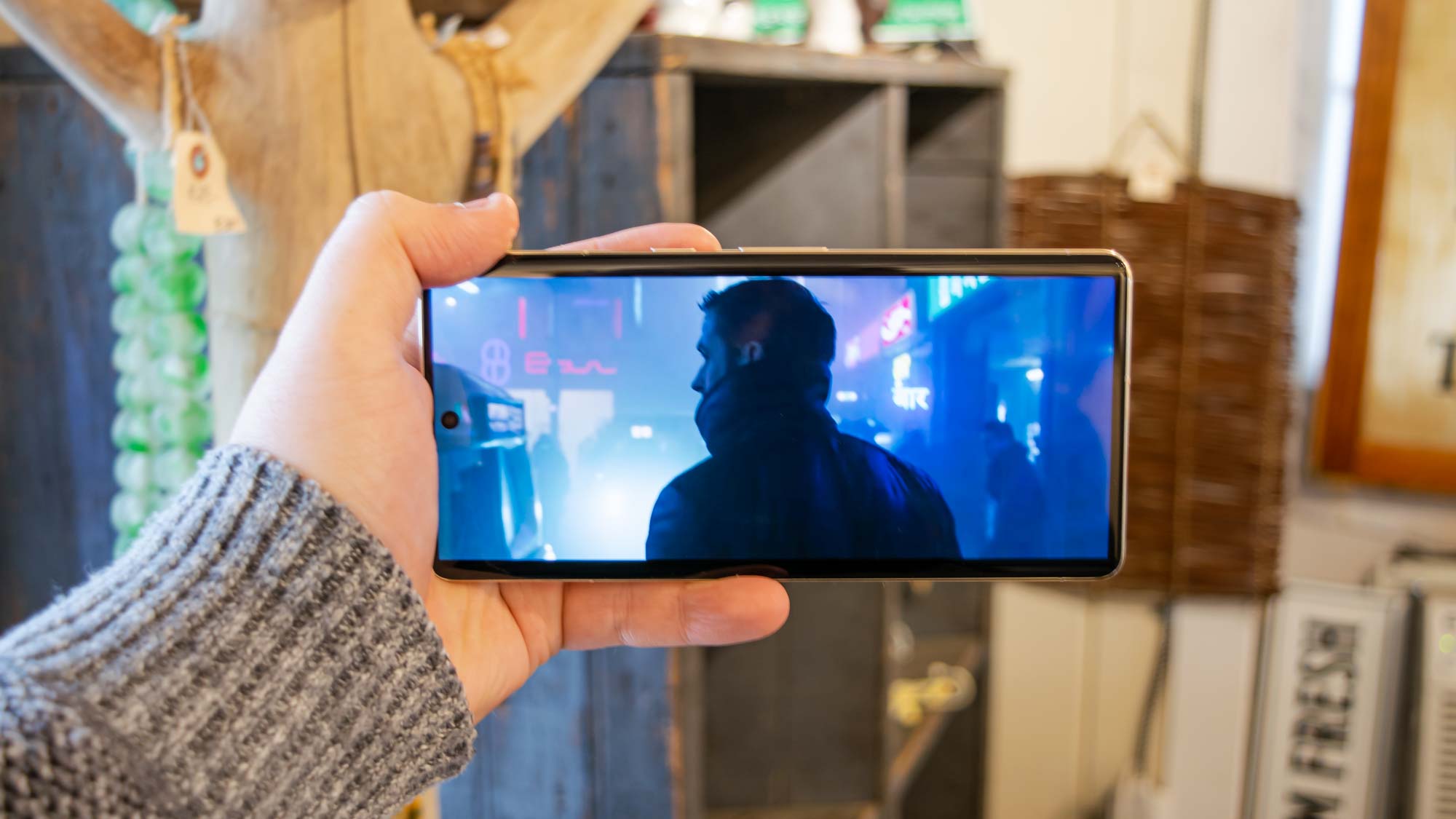
The Pixel 7 Pro certainly has a good display, even if it doesn’t quite measure up to Samsung and Apple.
Google Pixel 7 Pro review: Cameras
The Pixel 7 Pro sports a triple rear camera setup. The 50MP main sensor does the heavy lifting, and it performs just as well as I had hoped. The 12MP ultrawide sensor does a great job of capturing detail at a superwide angle. And then there’s the 48MP telephoto camera, rocking a 5x optical zoom level. Around front, the 10.8MP selfie cam does pretty well in most conditions.
Let's see how the Pixel 7 Pro's camera performs and be sure to check out our Pixel 7 Pro vs iPhone 14 Pro Max camera shootout for more comparisons.

The Pixel 7 Pro goes head-to-head with the iPhone 14 Pro (at $100 less), so that’s what I brought out for comparisons.
Starting off with this wall of metal stars, I love the rich detail in both images captured by the Pixel 7 Pro and iPhone 14 Pro. On that front, the two phones are pretty equal. Just look at the grain and cracks in the wood, the paint chips, the roughness of the stone, and striations in the stars.
However, you can see Apple’s Photonic Engine on display here. The brightness level stands as an immediate difference between the two. To my eye, the iPhone 14 Pro loses some detail in the stairs’ rust, whereas the grittier Pixel shot (given the overcast day) looks richer. Brighter is good, for sure, but Apple’s first round on the Photonic Engine is a bit aggressive here. I prefer the Pixel 7 Pro’s picture.
In this photo of a broken down Beetle, the images are once again nearly identical in terms of detail and dynamic range. I really like how the Pixel 7 Pro captured the plants and the faded auto paint, not to mention the flowers and pumpkins in the background. The iPhone 14 Pro did an equally nice job.
That said, I once again see the Photonic Engine getting a little aggressive in the background. The white flowers, for example, look on the verge of overexposure. The shot looks a bit too cool, whereas the Pixel 7 Pro captured a welcome and inviting warmness that I prefer given the weather conditions on the day I took these pictures. I once again give the nod to the Pixel.
Wrapping up the outdoor comparison, I took a picture of this part of New York City at night without either phone’s night mode active. I notice a much larger gap between the Pixel 7 Pro and iPhone 14 Pro here. The former wins in my opinion with a brighter image, stronger sense of detail and depth, and better colors on the mural. This was a very challenging scene with the very bright backlighting behind me, the night sky, and the lack of night mode. But I think the Pixel came out ahead.
Heading inside, this appropriately autumn scene shows that the Pixel 7 Pro and iPhone 14 Pro are on equal footing. Both phones have a wonderful sense of depth with the stuffed pumpkin in the foreground while the other pumpkins in the background are artistically out of focus. With the lamps, the scene looks very warm and inviting. The detail in the table catches my eye, too. It’s such a great performance from both devices that I can’t pick a winner.
In a much less flattering scene, I tasked both phones to capture my ramen at a little shop I found in New York. The Pixel 7 Pro’s shot looks blurry and soft, though the iPhone 14 Pro’s isn’t a whole lot better. This shop was dimly lit well into the evening, but neither device made the food look appetizing, despite it being quite tasty and appealing in real life. But the iPhone wins out by a hair with its use of the Photonic Engine and sharper focus, even if I prefer the colors in the Pixel’s shot.
In this ultrawide comparison of the pond behind my house, the story from the outdoor shots earlier holds true. Both the Pixel 7 Pro and iPhone 14 Pro did an incredible job, but you can see that the iPhone’s shot is brighter than the Pixel’s. Considering the well-lit conditions, I don’t think the Photonic Engine is necessary here, and I find myself preferring the more subdued look of the Pixel’s image. The plants in the foreground look more natural to me, whereas they’re a bit bright in the iPhone’s. I give this to the Pixel 7 Pro, but only just barely.
Both the Pixel 7 Pro and iPhone 14 Pro can zoom to 2x using their main cameras. In the former’s case, the image is cropped down to 12.5MP by splicing together data from the main and telephoto sensors using Google’s Super Res Zoom technology. In this scene, I think the iPhone wins. The colors are a lot more vibrant, whereas the Pixel has a dim and hazy look. The iPhone 14 Pro has slightly more attention to detail to my eye, too, such as with the pumpkins on the cart.
The Pixel 7 Pro’s telephoto lens tops out at 5x, while the iPhone 14 Pro only goes to 3x. So here’s that same scene as before with each phone at their max optical zoom levels. It’s hard to compare the two given that the iPhone got more of the surrounding scene in the shot. However, I think it beats the Pixel. It comes down to the colors — they’re just so much more vibrant in the iPhone’s image. The Pixel looks way too subdued and lifeless.
I knew the Pixel 7 Pro and iPhone 14 Pro would take good portraits, so I put them to the test in a tough situation. Here’s me sitting in direct and harsh sunlight with a variety of shadows both on and behind me. I dislike the Pixel’s attempt. I look way too red, which throws off the rest of the colors in my hair — such as my blond mustache looking redder than usual. Both phones did a great job with their bokeh effects, drawing attention to the subject. I also prefer the lighting in the iPhone’s portrait, whereas it looks like the Pixel struggled more with the harsh scene. (My eyes certainly did.)
I wanted to test the Pixel 7 Pro’s upgraded Night Sight and the iPhone 14 Pro’s excellent Night mode in what you might consider an ideal scene. With this basket of fruit at night, I think Apple wins. The shot is overall brighter and richer detail, though the Pixel produced some excellent colors. Considering the warm scene, I think the iPhone is more accurate, whereas the Pixel looks a little too cool given the situation. Both seem to struggle with a blurry background, though. (You can also check out our Google Pixel 7 Pro vs. iPhone 14 Pro Max: Low-light camera shootout for more on this).
Now, here’s a far less ideal situation. I took both phones down to my gaming setup in my pitch black basement with only the RGB from my PC to light the room. The Pixel 7 Pro and iPhone 14 Pro really struggled with this scene of my Xbox One controller. But ultimately, it seems like the Pixel won out. Not only is it a clearer image overall, but I can vaguely make out the blue X and yellow Y buttons on the controller, a detail I cannot discern in the iPhone’s attempt. So kudos to the Pixel 7 Pro for handling a ridiculously challenging situation as well as it did.
Moving to the front cameras, I took a selfie in a very well-lit room. I think I prefer the iPhone 14 Pro’s image sincehe Pixel 7 Pro applied too much face smoothing, making me look a little softer than I actually am. The iPhone captured more details in my face, such as the lines in my forehead and the ruddiness of my complexion. There’s also something off about my eyes in the Pixel’s selfie. They look blurry almost, as if the phone had trouble with the reflections in my glasses. So I give the win to the iPhone 14 Pro.
Finally, here’s a selfie indoors at night in that same ramen shop from earlier. The iPhone 14 Pro once again comes out ahead with sharper focus, better colors, and stronger detail. Exposure is also another point in the iPhone’s favor, which helps to make out more details in my face and shirt. The Pixel 7 Pro’s selfie is too dim and blurry for my taste.
And here’s a before and after example of the new Photo Unblur feature. Like Magic Eraser before it, Photo Unblur is very impressive, though still far from perfect. The before image here with the bookshelf is pretty blurry. You can barely make out the titles on some of the spines, but Photo Unblur cleans them up enough that I can read most of them.
It’s an excellent piece of software and I tested the Photo Unblur feature on other photos — and the results were pretty amazing.
Google Pixel 7 Pro review: Video
Up until this point, many have agreed that Apple is the way to go if you care about video recording on your smartphone. And while that might still be the case because of the ProRes capabilities on the iPhone 14 Pro, the Pixel 7 Pro is very quickly closing the gap.
New to the Pixel 7 Pro this year are two features that we’ve seen on iPhones. Cinematic Blur is Google’s version of the Cinematic mode that first appeared on the iPhone 13. This adds a bokeh effect to your videos much like a portrait photo. It tracks the subject as you pan the camera, or as the subject moves. You can see an example above with the Death’s Head moth display as I pan the camera around.
The Pixel 7 Pro keeps its focus locked on the subject while blurring the background. Like with photos, it really adds an artistic effect to the end product, drawing your eye to the thing you’re recording. All of this happens at 24 frames per second, further adding to the cinematic vibe.
Also new is Active Stabilization, which acts just like Apple’s Action mode on the iPhone 14. It provides super strong stabilization to your shaky videos, such as when you’re running. In fact, that’s what I did in this example. You can see the default stabilization attempt to correct for my running stride and poorly it does so.
But Active Stabilization keeps things under much better control. I compared this footage to the same I took with the iPhone 14 Pro during that review. I think Apple’s implementation is a bit more stable, but I will need to put both phones together to compare them directly. However, Google’s idea is a good one and the Pixel 7 Pro did a nice job of stabilizing the footage while I ran down the sidewalk.
Google Pixel 7 Pro review: Performance
Tensor G2 is yet another key highlight of the Pixel 7 Pro. The latest generation of Google’s in-house chipset aspirations, Tensor G2 has some serious upgrades over its predecessor. Not only is it more powerful — coming close to Qualcomm in our testing — but it offers far more AI and machine learning smarts with the new Tensor Processing Unit (TPU).
To see what Tensor G2 can do, we ran the Pixel 7 Pro through a suite of benchmarks. Here’s what we found.
| Row 0 - Cell 0 | Pixel 7 Pro | iPhone 14 Pro | Galaxy Z Fold 4 |
| CPU | Tensor G2 | A16 Bionic | Snapdragon 8 Plus Gen 1 |
| Geekbench 5 (single-core / multicore) | 1060 / 3046 | 1891 / 5469 | 1328 / 3831 |
| Geekbench ML (CPU / GPU / NPU) | 322 / 975 / 1824 | 1005 / 2482 / 3173 | 500 / 2196 / 3165 |
| 3DMark Wild Life Unlimited (FPS) | N/A | 74 | 53 |
| 3DMark Wild Life Extreme Unlimited (FPS) | N/A | 19 | 16 |
| Adobe Premiere Rush (Mins:Secs) | 0:47 | 0:26 | 0:45 |
I pulled out the Galaxy Z Fold 4 for this test to show how Tensor G2 stacks up to Qualcomm’s latest Snapdragon 8 Plus Gen 1. For the record, the newest Tensor performs better compared to the the Snapdragon 8 Gen 1, which is better than the Tensor G1 could say versus the Snapdragon 888 a year ago.
In Geekbench 5, for example, Tensor still lags behind both Qualcomm and Apple — by a significant margin in the latter’s case. But in the Adobe Premiere Rush 4K-1080p transcoding test, the Pixel 7 Pro kept up with the Galaxy Z Fold 4, though still almost double the length that it took the iPhone 14 Pro to complete the benchmark.
As for 3DMark’s graphics benchmarks, we had trouble getting the tests to run. Our Pixel 7 Pro review unit is running pre-production software, so we suspect that had something to do with the compatibility issues. Tensor G2 is a new chipset and it’s possible that 3DMark hasn’t updated its tests for it yet.
However, from a personal standpoint, I think the Pixel 7 Pro is a fine gaming device. It handled Genshin Impact and Apex Legends Mobile quite well, though not at max settings. I noticed a consistently smooth framerate, certainly better than the Pixel 6 Pro.
The Pixel 7 Pro still lags behind the iPhone 14 Pro and Galaxy Z Fold 4 in most respects here, but I definitely think Tensor G2 is a notable upgrade in all aspects.
Google Pixel 7 Pro review: Battery life and charging
The Pixel 7 Pro has a 5,000 mAh battery, which theoretically should be enough to make it last a long time. But the Pixel 6 Pro had the same size power pack and yet its battery life underwhelmed me at best.
We typically run a phone through a custom battery life test, where we set the display to 150 nits and then task the device to endlessly reload web pages until it dies. The Pixel 7 Pro produced an average time of 8 hours and 4 minutes across multiple tests, which is quite off the pace of the average smartphone's results. (Most phones run out of power just shy of the 10-hour mark.)

If you want to find some silver linings in that cloud, the Pixel 7 Pro's average time improved on the Pixel 6 Pro, but only by 9 minutes. The Pixel 7 Pro's time came with its adaptive refresh rate turned on; with that feature disabled, the Pixel 7 Pro lasted an average of 7 hours and 55 minutes on our test. So at least, ramping up the display refresh rate isn't draining battery life like it does on some phones.
It's also worth noting that our battery test is extremely demanding. In my regular usage, the Pixel 7 Pro outperformed its test result. I was able to get through hefty sessions of photography and gaming with juice to spare, just not as much as other phones. As a result, you can't really include the Pixel 7 Pro on the list of the best phone battery life.
For charging, the Pixel 7 Pro supports up to 30W wired, which is better than Apple’s 20W. Samsung still beats out Google with 45W, not to mention the likes of OnePlus or Xiaomi. Google has not disclosed the wireless charging speed, but I suspect it’s 21W like the Pixel 6 Pro, or close to that.
Google Pixel 7 Pro review: Software and special features
Android 13 isn’t entirely new — it’s been available for older Pixels since September — so it should come as no surprise that the Pixel 7 Pro ships with the updated phone software out of the box. On the surface, the software feels like it does on the Pixel 6 Pro or any other supported Pixel device. However, if you look beneath, you’ll find a host of neat features exclusive to the Pixel 7 Pro.
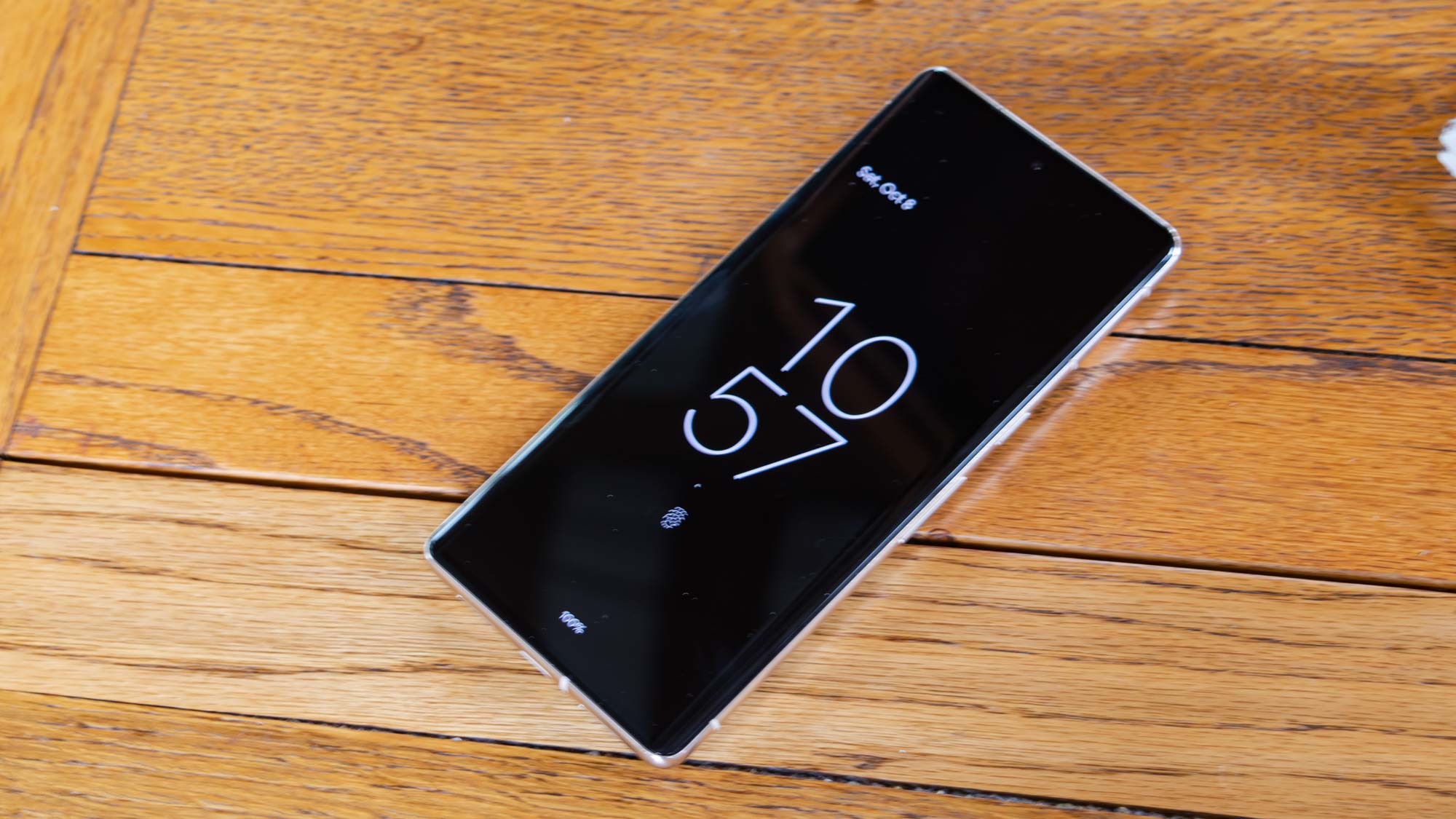
I should note that Google has not been super clear on how “exclusive” some of these things are. A few definitely appear to be related to Tensor G2, but others seem like they could extend to the Pixel 6 series.
I already spotlighted Photo Unblur above, but I failed to mention that Google says the Pixel 7 Pro can even unblur pictures in your Photos library using Tensor G2’s strength, even ones from several years ago. As you saw earlier, Photo Unblur is one sweet feature, easily matching Magic Eraser for me — though I personally find Magic Eraser more useful on a daily basis.
The Pixel 7 Pro expands the Call Assist suite that started with Call Screen. If you don’t recall, that is the Pixel-exclusive ability to screen calls before you answer them. The caller must declare themselves to you, which you can see and/or hear live. It’s a great way to weed out scammers, irritate family members, and scan robocalls.
Another part of Call Assist, Direct My Call, which transcribes business call directory options so you don’t have to remember them all, gets an upgrade with the Pixel 7 Pro. The options will now appear even before the automated voice has had a chance to read them out to you. It’s quite a marvel and I’m impressed. I hate making phone calls, and I especially despise those menus — I usually hold out my fingers in the number I think I need while I listen to the rest of the options. The Pixel 7 Pro has eliminated that.
Clear Calling also should show what Tensor can do. When you do have to talk on the phone, Clear Calling should help mitigate background noise while also boosting the caller’s voice so that you can hear more clearly. A beta of the feature has been available since October, with the full version arriving on both Pixel 7 models in early December. We're still evaluating it, but consider this one more way that Google tries to make its phones the best for doing actual phone things.
The Pixel 7 Pro has more up its sleeve than just phone call amenities. Assistant has gotten smarter thanks to Tensor, allowing it to understand your voice texts much better. With the Pixel 6 Pro, I was blown away at how contextually accurate Assistant was when voice typing. This year, Assistant can even suggest relevant emoji, even if you don’t remember the name of the one you wanted to send. The Pixel 7 Pro can also transcribe voice texts, but the feature did not appear to work during my review period.
The same software update bringing Clear Calling also introduced a new feature to the Recorder app that recognizes different speakers in recording transcriptions.
One part of the phone's software to watch out for though is the Markup tool, which until recently could have its edits undone after the fact due to the way Google Pixels save edited files.
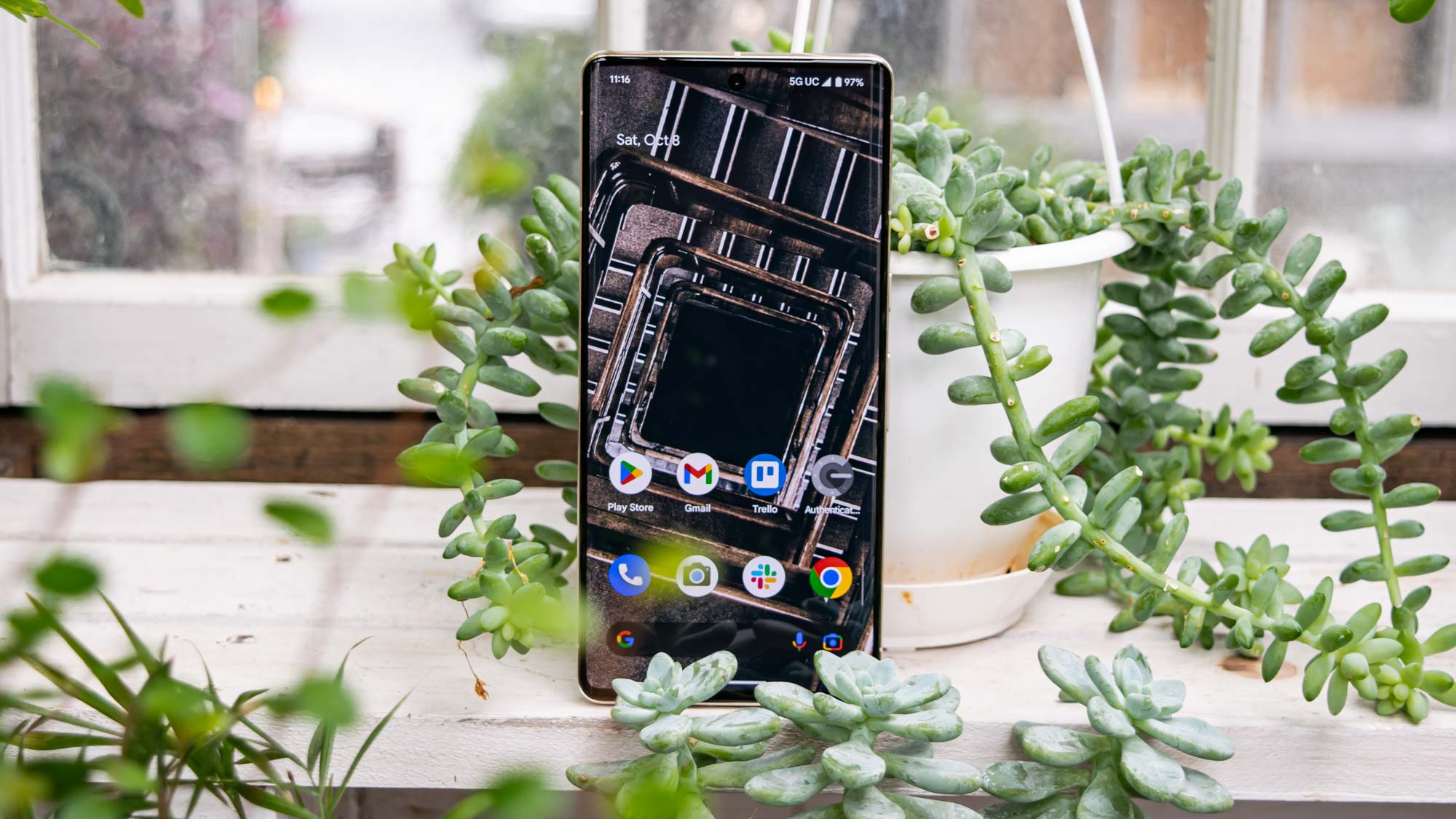
The Pixel 7 Pro stands to receive five years of security patches, and Google has announced users get free access to the Google One VPN for the full duration of that five years. Combine that with the secure software components in Android 13 and the Titan M2 chip, the Pixel 7 Pro will be one secure phone for years to come.
However, Google did let me down with software support. Again. The company has only committed to three years of platform updates, meaning the Pixel 7 Pro will stop at Android 16 in 2025. Considering that Google now owns the chipset, I see no excuse why the Pixel 7 Pro won’t enjoy at least four years like most Samsung phones do. Better yet, why not match the security update schedule? If people could trust their Pixel 7 Pro to go for as long as an iPhone, I think Google could earn more customers.
The Pixel software experience certainly stands out with its simple yet robust feature set. Material You is still here, adapting your system colors to your wallpaper. That means your Pixel will not look like mine. Material You exists for other Android 13 phones, too, but I think the Pixel 7 Pro best exemplifies it. Scratch that — I think the Pixel 7 Pro best exemplifies Android 13 period.
Google Pixel 7 Pro review: Verdict
I think that Google has finally realized its smartphone vision with the Pixel 7 Pro. This device is excellent, from the design to Tensor G2 and the cameras. As far as the latter goes, you will not find a better Android camera phone. Even the iPhone 14 Pro is on watch now. (You can check out our detailed comparison of the Google Pixel 7 Pro vs. iPhone 14 Pro Max as well).
If anything, I wish the Pixel 7 Pro would receive more than just three years of platform updates. Google owns Tensor, so I had hoped we would see Pixels be the iPhone equivalent in terms of support. Sadly, that dream has yet to come true.
I suggest that you consider the Pixel 7 Pro next time you’re in the market for a smartphone. The jury is still out on battery life and I will update this review when I have more data for you. For now, however, I really like this device, more than any other Android phone before it.
Overall, I feel pretty confident saying that the Pixel 7 Pro is one of, if not the, best Android phones you can buy. The current holder of that title, the Galaxy S22 Ultra, better look out. Google got a lot right this time around, even if the Pixel’s cameras alone are enough to make this handset worth it. I
In fact, our Global Editor-in-Chief, Mark Spoonauer, also thinks that after using the both the phones — the Pixel 7 Pro blows away the Galaxy S22 Ultra.

Jordan is the Phones Editor for Tom's Guide, covering all things phone-related. He's written about phones for over six years and plans to continue for a long while to come. He loves nothing more than relaxing in his home with a book, game, or his latest personal writing project. Jordan likes finding new things to dive into, from books and games to new mechanical keyboard switches and fun keycap sets. Outside of work, you can find him poring over open-source software and his studies.
-
Timnelsonic I recently upgraded from the Pixel 5 to the Pixel 7 Pro. I love the phone with one BIG exception: the battery life is horrible. The article lightly touches on battery life by saying it was quantitatively awful but qualitatively it didn't seem that bad. If I read the data correctly, Tom's testing showed it getting about half the life of the latest iPhone.Reply
I thought maybe it was just me but searching around I find others commenting on the battery as well. There is some guidance floating around that if you turn off a bunch of features, then you might get through the day without charging, but that seems to defeat the purpose of having a high-end phone. In any case, under light use, the phone lasts until late afternoon. Under heavier use, it's dead mid-day and needs a full recharge. No bueno.
I really want to love this phone, but I think I need to return it and try something else. -
Einstein_Jr I just got a Pixel 7 pro. I'm still adjusting it and need to configure it to my tastes. That's Fine!Reply
What I don't like is that it freezes too much. I've had it less than 24 hours and has frozen probably ten times with fully updated software on different apps.
